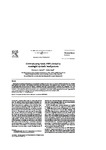Communicating hands: ERPs elicited by meaningful symbolic hand postures.
| dc.contributor.author | Gunter, TC | en |
| dc.contributor.author | Bach, P | en |
| dc.date.accessioned | 2012-05-24T12:24:24Z | |
| dc.date.available | 2012-05-24T12:24:24Z | |
| dc.date.issued | 2004-11-30 | en |
| dc.identifier.issn | 0304-3940 | en |
| dc.identifier.uri | http://hdl.handle.net/10026.1/1021 | |
| dc.description.abstract |
Meaningful and meaningless hand postures were presented to subjects who had to carry out a semantic discrimination task while electrical brain responses were recorded. Both meaningful and control sets of hand postures were matched as closely as possible. The ERPs elicited by meaningless hand postures showed an anteriorly distributed N300 and a centro-posteriorly distributed N400 component. The N300 probably reflects picture-specific processes, whereas the N400-effect probably reflects processing in an amodal semantic network. The scalp-distribution of the N400-effect, which is more posterior than usually reported in picture processing, suggests that the semantic representations of the concepts expressed by meaningful hand postures have similar properties to those of abstract words. | en |
| dc.format.extent | 52 - 56 | en |
| dc.language | eng | en |
| dc.language.iso | eng | en |
| dc.subject | Adult | en |
| dc.subject | Analysis of Variance | en |
| dc.subject | Evoked Potentials | en |
| dc.subject | Female | en |
| dc.subject | Hand | en |
| dc.subject | Humans | en |
| dc.subject | Male | en |
| dc.subject | Movement | en |
| dc.subject | Photic Stimulation | en |
| dc.title | Communicating hands: ERPs elicited by meaningful symbolic hand postures. | en |
| dc.type | Journal Article | |
| plymouth.author-url | https://www.ncbi.nlm.nih.gov/pubmed/15531087 | en |
| plymouth.issue | 1-2 | en |
| plymouth.volume | 372 | en |
| plymouth.publication-status | Published | en |
| plymouth.journal | Neurosci Lett | en |
| dc.identifier.doi | 10.1016/j.neulet.2004.09.011 | en |
| plymouth.organisational-group | /Plymouth | |
| plymouth.organisational-group | /Plymouth/REF 2021 Researchers by UoA | |
| plymouth.organisational-group | /Plymouth/REF 2021 Researchers by UoA/UoA04 Psychology, Psychiatry and Neuroscience | |
| plymouth.organisational-group | /Plymouth/Research Groups | |
| plymouth.organisational-group | /Plymouth/Research Groups/Centre for Brain, Cognition and Behaviour (CBCB) | |
| plymouth.organisational-group | /Plymouth/Research Groups/Centre for Brain, Cognition and Behaviour (CBCB)/Brain | |
| dc.publisher.place | Ireland | en |
| dcterms.dateAccepted | 2004-09-03 | en |
| dc.rights.embargoperiod | Not known | en |
| rioxxterms.versionofrecord | 10.1016/j.neulet.2004.09.011 | en |
| rioxxterms.licenseref.uri | http://www.rioxx.net/licenses/all-rights-reserved | en |
| rioxxterms.licenseref.startdate | 2004-11-30 | en |
| rioxxterms.type | Journal Article/Review | en |


